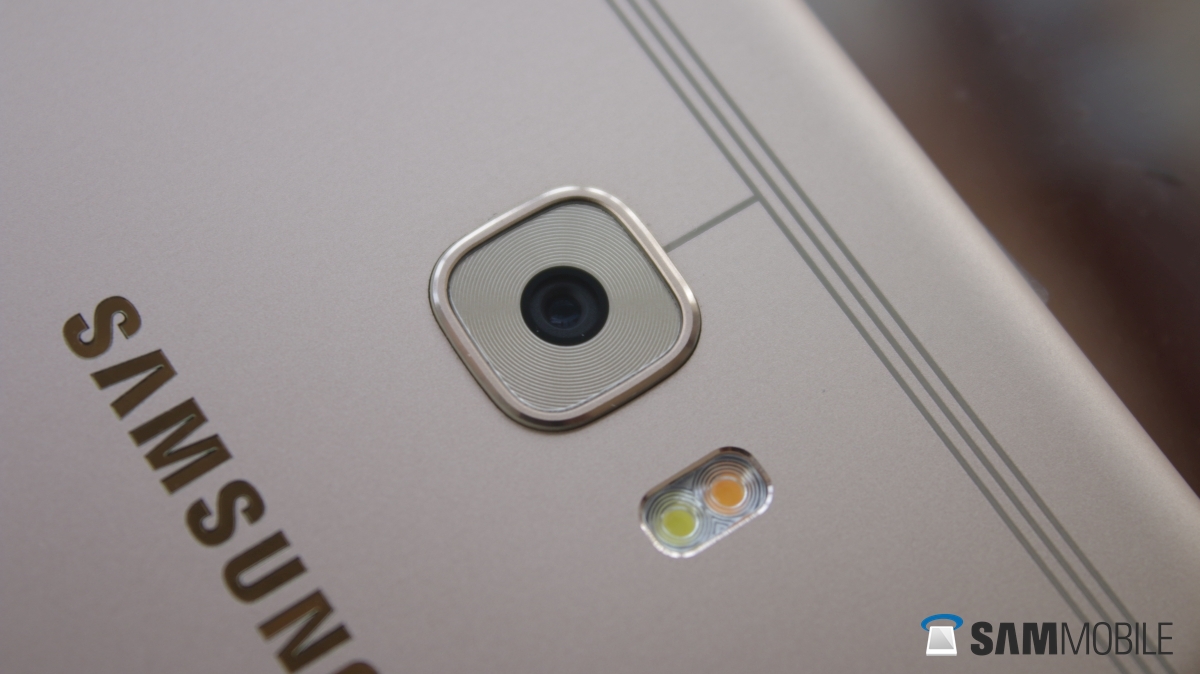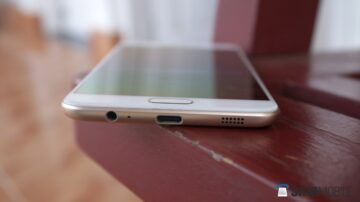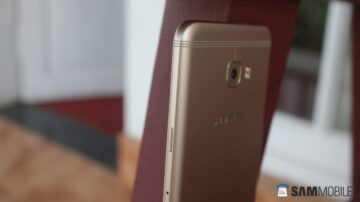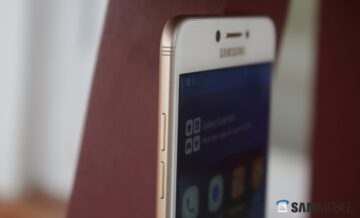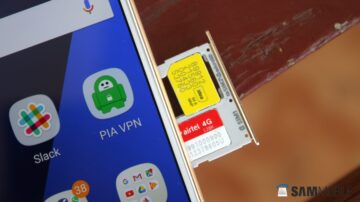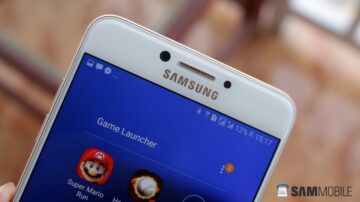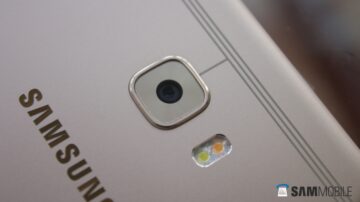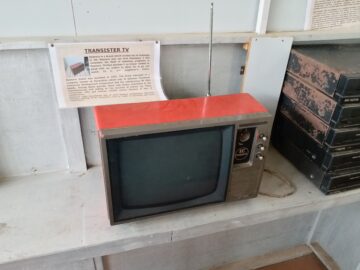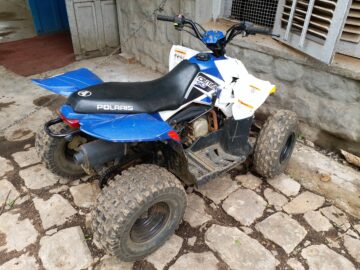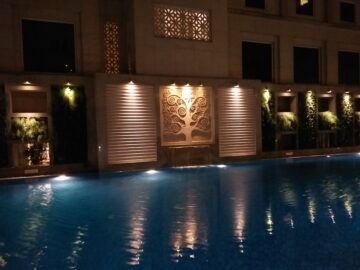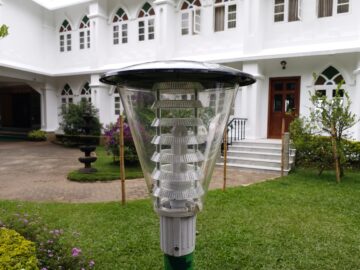The
Galaxy C7 Pro, like the Galaxy C9 Pro, is hard to get hold of unless you live in China or India, as Samsung isn't making its Galaxy C series of mid-range phones available globally. It probably never will, as the Galaxy A lineup is what the Korean giant is using to woo consumers outside the Asian continent. The problem is, the A series is also available in China and India, making the C series somewhat redundant as far as keeping the Galaxy lineup simple is concerned.
Perhaps the biggest differentiation you can find between the Galaxy C and A series phones is the way they are designed. The former eschews the latter's glass and metal build and goes all in with metal; it retains the premium quality as a result, but Samsung is offering one feature on the C series phones that you won't find on any other Galaxy smartphone. That feature is stereo speakers, which many were disappointed to see missing on the new Galaxy S8 and S8+.
Here in India, at Rs. 27,990 (roughly $435), the Galaxy C7 Pro undercuts the Galaxy A5 (2017) and Galaxy A7 (2017) on pricing thanks to its online-only sales model. While it isn't waterproof like the A series phones or have Samsung Pay support, it does get better specs in areas that some would say matter more. There's an extra gig of RAM, the aforementioned stereo speakers, and 64GB of internal storage (along with a microSD slot). The Snapdragon 626 processor is clocked higher than the Exynos 7880 on the A7 (2017), too, and I've already talked about how it offers notably better performance.
In fact, while the C7 Pro might not seem as fast as the C9 Pro (which gets the much faster Snapdragon 653 SoC and 6GB of RAM), its performance is still comparable despite the $100 lower price tag. The 16 MP front and rear cameras have carried over intact, making the C7 Pro one of the most feature-packed Samsung smartphones in the mid-range category.
But as we have seen with non-flagship Samsung devices, the overall experience is never one that matches the on-paper specs. There's also competition like the OnePlus 3, which also sells online in India for a similar price but with flagship-grade specs, to tackle. Does the C7 Pro have what it takes to offer a worthwhile experience? Well, let's dive into the review and find out.
Design
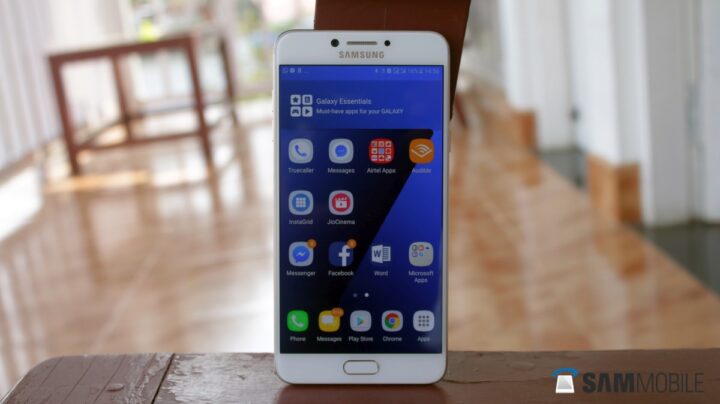
At 7 mm, the Galaxy C7 Pro is one of the thinnest mid-range phones Samsung has launched. It's what helps the 5.7-inch display be more ergonomic and comfortable to handle, although it's still not a one-hand device. The phone has a unibody metal design the same as the C9 Pro's, and once again, Samsung has opted to make the front side completely white on the gold variant. The white front makes the phone look like a few Chinese devices, so it's not the color option you should go for unless you happen to like white too much.
The C7 Pro feels as premium as the new Galaxy A (2017) devices, and the lack of glass on the back means it should be better protected against damage from drops (of course, the screen still stands to break, so don't go dropping the phone too often). Everything is where we expect it to be on Samsung devices (well, before the Galaxy S8, at least). There's the home button with the fingerprint sensor up front, and you also get a USB Type-C port at the bottom, next to the primary loudspeaker (the earpiece works as the other speaker).

Around the back, the 16-megapixel camera module juts out of the body ever so slightly, so there's no wobble when you try to use the phone while it's sitting on a flat surface. As on the C9 Pro, three small lines run across the back near the top and bottom of the device, giving it a visual touch that isn't present on devices in other Galaxy lineups. On the right side of the phone, you get a hybrid SIM slot that can either take a secondary SIM or a microSD slot.
The build quality of the phone is excellent, and it's thin without bordering on the verge of being too sleek. I just wish Samsung would stop making its C series devices all white from the front, as that really takes away the visual appeal. The navy blue variant no doubt looks much better, but Samsung sadly sent us the gold variant for review for both the C7 Pro and C9 Pro.
Display

The Galaxy C7 Pro comes with a 5.7-inch Full HD Super AMOLED display, and as expected, it's an excellent panel that only falls short of the AMOLED displays Samsung uses on its flagships. Colors are vivid, viewing angles are wide, and the blacks are really black. The only complaint I have is that the display looks to sit slightly below the glass, although this might be noticeable because the phone is white, which makes the black borders around the display stand out. The screen's brightness is also impressive, and I never had issues making out what's on-screen out under the bright Indian sun.
The display comes set to Adaptive display mode by default, and this mode is best for those who like a vivid viewing experience. There's Basic mode for those who like accurate colors, although in basic mode the screen gets a tad too warm, and there's no setting to change that. AMOLED Photo is the middle ground; it's not as vivid as Adaptive mode nor as, well, basic like Basic mode.
Camera

The cameras are perhaps the only truly disappointing part of the C7 Pro, and it's not just this device that is to blame. The cameras on Samsung's recent mid-range phones have been rather average. The company has taken away features like optical image stabilization, which results in blurry shot indoors and in low-light conditions. The front cameras have gone all the way up to 16 megapixels in resolution, but that hasn't translated into the kind of detail one would expect.
The 16-megapixel rear camera takes detailed shots with accurate colors outdoors in well-lit conditions, but as soon as lighting becomes artificial or you go indoors, image quality deteriorates. Color accuracy goes down, and as I said earlier, many photos come out with noticeable blur unless you were holding the phone extremely steady. Focusing also becomes slower, and you can pretty much forget about quickly capturing important moments or fast-moving subjects when the lighting isn't great. Perhaps the saving grace here is that photos are saved very quickly, although that is true of any phone these days and is no longer an attractive feature.
The camera app on the C7 Pro is the same as the one found on the new A series phones and other Marshmallow-powered non-flagship Galaxy devices. You swipe to access things like camera modes and filters, and can also swipe up and down on the screen to switch between the front and rear cameras. Samsung's new floating camera button is also an option here – this puts an additional shutter button on the viewfinder, one that you can place anywhere you like.
The shooting modes are the usual fare. There are dedicated HDR and night modes, and you also get panorama, food, and pro modes. Pro mode is basic in its options; you can change exposure, ISO, white balance, and metering modes, but there's no option to change shutter speed or save pictures in RAW. You can also download a couple of additional shooting modes, including rear-cam selfie (which automatically shoots photos via the rear cam once it detects faces) and sports shot.
Here are a few camera samples.



Selfie camera
The selfie camera, as I noted above, is not as nice as one would expect a 16-megapixel sensor to be. Despite all the megapixels, there is a strange lack of detail in selfies, unless it's real bright outside. Like the rear camera, images also come out a bit blurry, and with the selfie camera, it's not just a problem in poor lighting. Even selfies taken in ample light outdoors are prone to blur, especially if you use the volume buttons to capture images. Thankfully, Samsung has built in palm capture and voice control. The former allows you put your palm in front of the camera to initiate timed capture; voice control lets you shout out cheese or smile or capture to take photos, and it works pretty well in all but the noisiest environments.

Shooting modes for selfies include a dedicated night mode, a wide selfie mode, and continuous shot. Wide selfie is like panorama for selfies, and you can move your phone around in a particular direction to capture a wider selfie in order to fit in more people. Night mode is useful for getting more light out of a scene, but if that doesn't work well enough, you can enable the flash. The flash is software-based as we've seen on other Samsung phones and turns the screen a bright white for a moment to emulate an actual flash. Of course, you also get a beauty mode, with the option to change skin tone, enlarge your eyes, and slim down your face.
Here's are two selfie samples. Notice the blur in the second one, which was taken in perfectly good lighting.
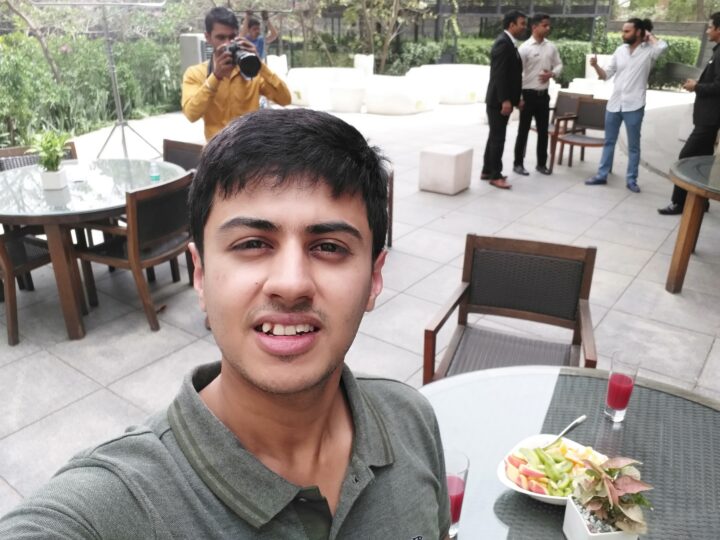

Performance
This is where the Galaxy C7 Pro surprised me. On paper, the octa-core Snapdragon 626 processor with its Cortex-A53 cores would make you think the phone is all about efficiency and not performance, but I was glad to see that the C7 Pro performs great. It's even comparable to the C9 Pro with the much faster Snapdragon 653 chipset, and I found performance to be miles ahead of the Galaxy A7 (2017), which is powered by the Exynos 7880, an equivalent of the Snapdragon 626 but with slightly lower clock speed.
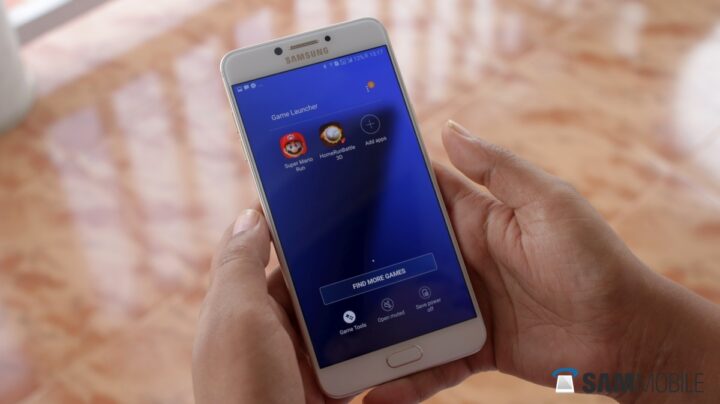
The interface remains smooth throughout, and apps fire up quickly. Also quick is switching between different apps, with the phone keeping quite a few apps in memory at all times, if not as many as the C9 Pro with the extra two gigs of RAM. Games ran great, too. Modern Combat 5 runs smooth at the highest setting, and while you don't get all the graphical bells and whistles as you do on flagship phones, the overall experience remains excellent.
I also like the fact that the C7 Pro comes with 64GB of storage out of the box. I didn't use a microSD card over the course of my review, yet never saw the phone lacking for space despite having a ton of apps installed. It's impressive that you get so much built-in storage, as even flagship phones (except Samsung's own) are still shipping with 32GB on the base models. It also helps if you want to use two SIM cards with the phone, as the SIM slot is a hybrid one that can either take a second SIM or a microSD card.
If you read my review of the C9 Pro, you'll remember that I didn't think highly of the fingerprint sensor. Thankfully, Samsung seems to have made improvements on the C7 Pro. It's more accurate and fails less often, although there were still instances where I thought my finger was placed on the sensor properly yet the phone couldn't detect it. Again, that doesn't happen too frequently. Oh, and the fingerprint sensor is always active, so you don't have to press the home button to wake the phone and unlock it. Just keep your finger on the button, and it unlocks in a second or two.
Audio Quality

The Galaxy C7 Pro gets stereo loudspeakers, like the Galaxy C9 Pro. The earpiece doubles up as the second speaker, in a setup that is becoming common on smartphones (examples include the iPhone 7 and new HTC phones). Unfortunately, the earpiece can't keep up with the primary loudspeaker at the bottom of the phone, so the stereo sound isn't as nice as one would expect. It is better than any other Samsung phone before the Galaxy S8, and since the earpiece works as one of the speakers, whatever you play isn't fully directed away from you. In fact, I found the audio output to be comparable to the iPhone 7's, which currently has the best stereo speaker setup on smartphones, although the sound isn't as deep or bass-heavy as I would have liked.
As for the supplied earphones, they have the same quality as the earphones Samsung offers with its flagships (the non-AKG ones from before the Galaxy S8). The earphones are geared towards the higher frequencies (treble) so there isn’t a lot of bass, although you can rectify that by playing around with the sound settings. The equalizer offers a UHQ upscaler option that results in clearer sound from high-quality tracks, and a surround sound toggle to, well, emulate the effect of “rich surround sound.”
Software

Like the Galaxy C9 Pro, the C7 Pro runs Android 6.0.1 Marshmallow with a new version of TouchWiz that gets a few features and functionality as Nougat on the Galaxy S series. There's a blue light filter, grouped notifications, and a few more features that you get here despite not having Nougat. Of course, it's sad the phone was even launched with Marshmallow here in 2017, but Samsung will hopefully bring out an update without making us wait too long.
For a full rundown on how the C7 Pro’s software works, read the software section of our Galaxy A5 (2017) review, as both handsets are similar on the software front.
Battery Life
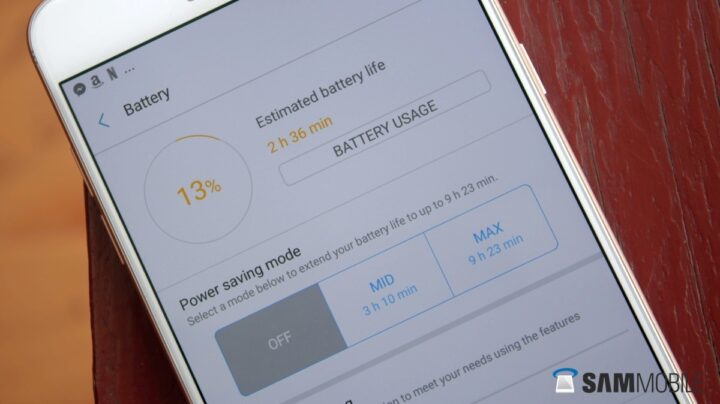
The Galaxy C9 Pro was not great at battery endurance, despite a 4,000 mAh battery, so I was skeptical when I saw that the C7 Pro had only a 3,300 mAh battery. Well, the reduced capacity didn't translate into poorer battery life. In fact, the C7 Pro managed to churn impressive endurance, and I'm sure the efficiency focused Snapdragon 626 chipset helped. I didn't get to use the phone extensively over a single day, so I'm not sure how it would last with heavy usage (you can blame it on the Galaxy S8's arrival between my review period), but with moderate usage, you can expect the phone to last until the next morning before needing a charge.
The Galaxy C7 Pro gets fast charging support, and going from 0 to 100 percent took around 2 hours. There are Samsung's usual power saving modes available, although the only time I enabled the standard power saving mode was when I was tethering its LTE connection to other devices. Like the C9 Pro and the Galaxy J7 Prime, the C7 Pro gets a couple of unique power saving modes focused on saving battery for calls (calling is still an important function on phones here in India, unlike in the Western world), and you can see more details on the same in the battery section of our Galaxy J7 Prime review.

I should also note that the C7 Pro comes with a USB Type-C port, so your microUSB cables won't work here. Well, not directly, but Samsung thoughtfully continues to offer a microUSB to Type-C converter. If you're looking for good USB Type-C cables, don't forget to take a look at list. The list is for the Galaxy S8, but these cables will work fine with any device with a Type-C port.
Wrap Up
The Galaxy C7 Pro took me by surprise. It's not as loaded as the Galaxy C9 Pro in terms of specifications, but it still manages to offer a similar experience at a $100 lower price tag. Performance is excellent from a chip that is made for power efficiency, the design is thin and feels premium, the battery lasts long and charges quickly, and the stereo speakers and beautiful AMOLED display make it a good fit for watching videos and playing games. 64GB of internal storage is another advantage, and something other manufacturers would do well to take inspiration from.
The average cameras are what let the phone down, and I wish Samsung would start putting some work behind the imaging prowess of its mid-range phones. There's also no Samsung Pay support. The C9 Pro doesn't have it either, so it looks like Samsung isn't willing to offer its payment service on the C series phones just yet. It's not because their availability is limited, as the Galaxy A9 Pro, another handset that's not available in most markets, does get Samsung Pay support.
The C7 Pro's biggest competition comes from the OnePlus 3T, which is considered the best smartphone available under $500 and offers flagship specs like a Snapdragon 821 processor. The new Galaxy A series handsets, with features like water resistance and Samsung Pay support, are also direct competitors from Samsung's own camp, although I believe the C7 Pro does a better job at things that matter most. Of course, what features matter more to you will sway your decision towards one or the other.
To close, I would say the Galaxy C7 Pro is the most complete and all-rounder mid-range phone Samsung has ever launched. It's not perfect, and you can get many smartphones with better specs from Chinese manufacturers for a similar price. But if you like Samsung phones and are looking for a new one that doesn't break the bank, the Galaxy C7 Pro is a great option, and one you should look out for if you live in a market where it is available.
| Pros |
Cons |
| Thin, premium design |
16MP selfie camera is average |
| Excellent display |
Rear camera poor in low light |
| Impressive performance |
No Samsung Pay support |
| Battery lasts long |
Gold variant is all white at the front |
| Stereo speakers offer somewhat immersive sound |
| 64GB internal storage |
|
| Rear camera does well in daylight |
|
 Samsung Galaxy Watch 8 review
Samsung Galaxy Watch 8 review Samsung Bespoke AI Jet Ultra review
Samsung Bespoke AI Jet Ultra review Samsung Galaxy Z Fold 7 review
Samsung Galaxy Z Fold 7 review Samsung Galaxy Z Flip 7 review
Samsung Galaxy Z Flip 7 review Samsung Galaxy S25 Edge review
Samsung Galaxy S25 Edge review Samsung S95F OLED TV review
Samsung S95F OLED TV review Samsung Q7F QLED TV review: A no-brainer purchase at its low price
Samsung Q7F QLED TV review: A no-brainer purchase at its low price Samsung S90F OLED TV review: Unreal value for money
Samsung S90F OLED TV review: Unreal value for money Samsung Galaxy S25+ review: Nails the big phone basics
Samsung Galaxy S25+ review: Nails the big phone basics





